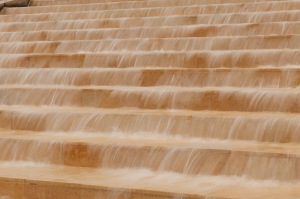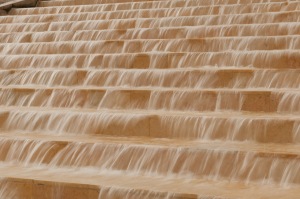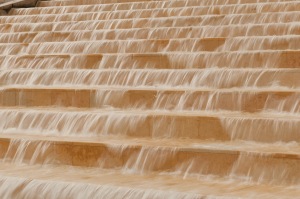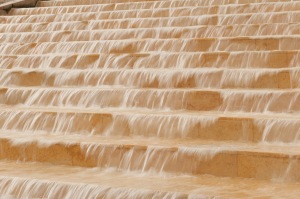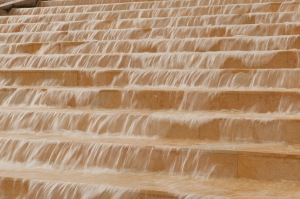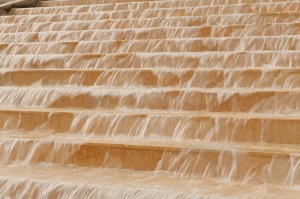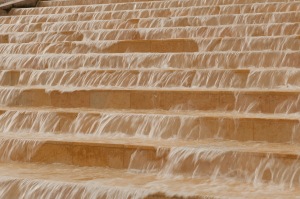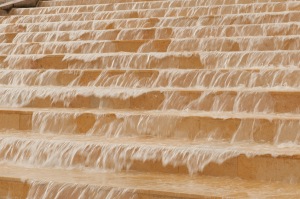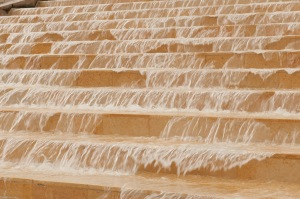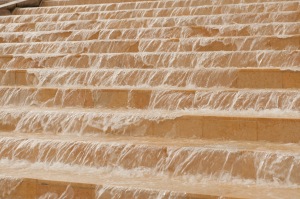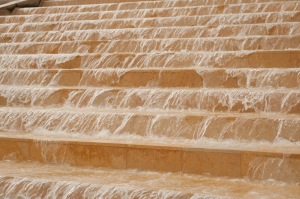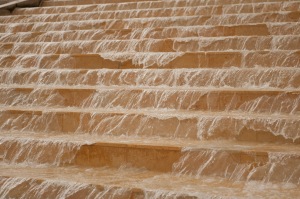In my mind the jury is still out on “creamy water” so I chose to use a water scene for this exercise as part of my own journey to making a a personal decision on this aspect of photography; in this case it is the water feature in Millennium Square in Bristol, which, fortunately was functioning on the day I visited, having since discovered it is often switched off (a frequent target for revellers with soap powder!); given the simplicity of this feature I felt it would provide an ideal scene. Conversely the weather was far from ideal, cold with a mixture of rain and snow!
Photo 1. Classic creamy water with no definition of the individual streams or splash. It conveys a continuos stream of water and adds a softness to the image.
Photo 2. Very similar to Photo 1 as to be expected with a small difference in shutter speed.
Photo 3. Still a good deal of creaminess but there is some slight definition of the individual streams of water beginning to appear.
Photo 4. Very similar to Photo 3, again I would expect this given the small change in shutter speed.
Photo 5. A little more definition beginning to appear as the creaminess reduces.
Photo 6. Rather than creaminess I would call this blurring of the movement and individual streams of water are better defined.
Photo 7. Still plenty of blur but not significantly different from the previous shot. Again, the difference in shutter speed is small.
Photo 8. A slight reduction in blur.
Photo 9. Reduction in blur creating more of an impression of the power of the water. The movement is still not sharply frozen.
Photo 10. I was expecting to see some sharpness at this speed and my initial impression was that the turning point had been reached. However, when zooming in on the screen it was evident that it was not sharply frozen.
Photo 11. There is a definite improvement in sharpness now but still not optimum when zoomed in.
Photo 12. I would expect there to be a significant improvement in sharpness at this speed. Indeed, when viewed in comparison mode with Photo 11 in Lightroom there is a significant improvement in the sharpness of the frozen movement of the water. Also the bubbles and splash are well defined. However, again in the zoom mode I do not see the sharpness that would define this as the transition point.
Clearly I have not picked a spread of shutter speeds where the transition to sharply frozen movement is clearly defined and I should have explored shutter speeds greater than 1/250 sec. In conclusion, therefore, I do not think I have found the shutter speed which clearly defines the transition to sharply frozen movement as this exercise set out to do. However, a number of lessons have been learnt; my planning for this exercise fell short in that I had not thought through the range of shutter speeds to be used – more research of photographs of this type of scene would have provided the clues ergo taking the advice to build up a folder of photos for future reference; it is difficult to assess photographs on the camera LCD monitor, particularly in adverse conditions, so better to take more shots across the range of settings to ensure the required spectrum is captured. However, I have also learnt some more functionality of Lightroom for comparing shots. As regards the “creamy water” issue, I am still inclined to the view that some take it too far but I guess it is a very subjective aspect of a photograph and what one is trying to convey.

